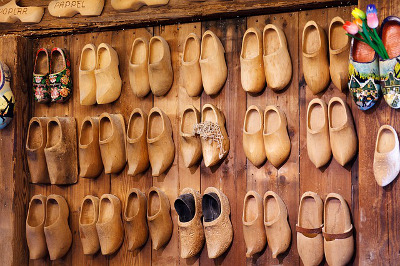The Clog 31st January 2016

In the small town of Mytholmroyd in a valley near to our HQ in Halifax, West Yorkshire, there is a small but thriving business called Walkley. They’re one of only a handful of remaining clog-makers in Britain
It will come as a surprise to some that there are any clog-makers still around, but in fact clogs are an environmentally-friendly and efficient type of footwear. Clogs can withstand extremes of temperature and as such as prized in the metal-working industry and similar professions such as foundries and glassworking concerns. In fact, although clogs may have been around since Roman times, it was with the Industrial Revolution that they took off in popularity in Britain, when workers had a great need for strong yet cheap footwear. The low cost of clogs was due to the fact that Britain was (and is, to some extent in certain areas) covered by woods and forests, where grew certain trees such as the alder, beech, sycamore, ash and willow, all of which provided plentiful wood that was ideal for clog-making. (As an aside, the aspen tree also provided wood which was ideal for making clogs, but it was specifically banned in England as a clog-making material as the government wanted to preserve it for the making of arrows for England’s national weapon, the longbow.)
Although associated in the popular mind with the North, in fact clogs were worn around the country, especially in markets and mines, where their low cost and durability were again appreciated.
In fact, clogs are not a British phenomenon. The French sabot is a type of clog made entirely from wood (unlike British-style clogs which tend to be a leather upper on a wooden base). Some say the word “sabotage” is derived from these clogs, when disgruntled workers would stop factory production by throwing their clogs into the inner workings of machinery! From Germany we have the Holzschuh, also a fully-wooden clog, and from Italy the Zaccolo, which can be either fully-wood or partly-wood.
And traditional clogs can be found further afield: Turkey, India, China, Japan, Korea and the Philippines all have their own national clog styles, although these Asian clogs are more “clog-sandals” than the European-type “Clog-shoes”.
The Indian Paduka is the most quintessential and ancient type of Indian footwear and is extremely simple in design and concept: it is simply a wooden sole with a knob which goes between the big toe and the second tow. However, although simple in design, they can be elaborate in appearance: the rich have often decorated them lavishly and used fine woods for their manufacture, such as teak, sandalwood or ebony.
Hailing from Japan, the Geta is a sandal-type clog with a wooden base elevated by the addition of two wooden blocks beneath, and held onto the foot with an elastic thong. They are worn with traditional Japanese clothing (such as a kimono or yukata), but also with Western-style clothing during summer.
_____
The modern British-made safety clog is so tough that it is at least twice as strong as a safety boot, according to manufacturer Walkley. UK regulations are so tight that Walkley’s safety clogs are actually tested to the European EN 345 safety footwear standard. In short, this footwear can really protect your feet. If you’ve a job which involves standing in something hot or otherwise unpleasant, or where there’s a good chance that you might drop something heavy on your feet, the safety clog might be a good option for you!
If you enjoyed this article - please share with your friends...
